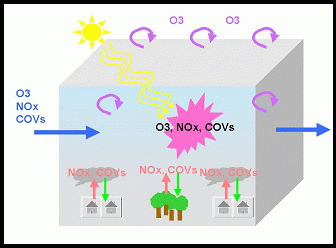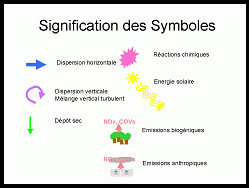Introduction >> Modèle
Air quality modeling
in PREV'AIR
- Three-dimensional Deterministic Modelling
- Numerical Resolution
- Physical-Chemical Processes
- Input data
- References
The three-day forecasts and air quality maps published on a daily basis on the PREV’AIR server are the result of numerical simulations carried out with the help of so-called 3D eulerian deterministic models ("chemistry-transport" models). For periods of time ranging from several days to several months, these tools allow to calculate changes in photochemical and specific pollution in the lower layer of the atmosphere, on different spatial scales.
The models used in the PREV’AIR system have been developed by the project’s partners:
- The Pierre-Simon Laplace Institute of the National Center for Scientific Research (IPSL / CNRS) and the INERIS for the CHIMERE Model,
- Centre National de Recherches Météorologiques de Météo France (CNRM / Météo France) for the MOCAGE model
Three-dimensional Deterministic Modelling
A three-dimensional area includes the low troposphere above the region being studied. The changes in pollutant concentrations in this three-dimensional area over the chosen period - influenced by weather conditions and emissions of pollutants into the atmosphere - are calculated in a deterministic manner, i.e., by linking temporal variations in such concentrations to:
- transport phenomena and physical-chemical processes of production and loss of chemical compounds;
- concentrations of chemical compounds at the boundaries of the domain;
- concentrations of chemical compounds at the start of the time period being studied ("initial concentrations").
Numerical Resolution
A system of partial differential equations (PDE) translates - or "models" - this complex of phenomena into mathematical terms.
The PDE system that describes the transport and the physics-chemistry of atmospheric pollution is then numerically solved on calculating machines, with the help of a numerical scheme adapted to the type of PDE to be processed.
In the eulerian three-dimensionnal approach, EDPs are projected in each spatial direction..
The numerical resolution of the EDPs entails spatial discretisation of the considered three-dimensional area: this is described by a vertical and horizontal grid with a spatial resolution that depends on the following factors:
- Size of the area,
- Properties - particularly the lifespan - of the pollutants,
- Computer resources (performance of the calculating machines, as regards operating speed but also as regards storage of results),
- input data (particularly emission registers).
The concentrations calculated by the models in each grid cell are the average concentrations that would be observed if there were a perfect mix in each sector, which is rarely the case.
Likewise, numerical resolution of the PDEs entails temporal discretisation of the period being studied. Changes in concentrations of pollutants are calculated with a temporal resolution (defined by the time step) that depends on the spatial grid, the duration of the period in question and, obviously, on the properties of the pollutants, the computer resources and the input data.
Physical-Chemical Processes
In the deterministic chemistry-transport models used within the context of the PREV’AIR system, changes in pollutant concentrations over time are calculated by linking the variation of pollutant concentrations in the area over time to physical-chemical processes that increase (production processes) or reduce (loss processes) the concentration of a chemical compound in the atmosphere.
|
For example, the following physical-chemical processes are used in the CHIMERE-Continental model:
|


|
|
|
||
Input data
In order to calculate the flows of production or loss of pollutants related to physical-chemical processes, a certain amount of input data must be provided for the chemistry-transport models, particularly pollutant emissions and meteorological data. These input data must be obtained from a number of bodies.
- Chemistry-transport models do not produce their own meteorological data, which are necessary to assess the flows related to the processes of dispersion, mixing, deposition, chemical reactions, etc. It is therefore necessary to enter meteorological data as input for the area to be modelled and the period we wish to simulate. In PREV'AIR, models use data provided by meteorological models.
- The area over which the pollutant concentrations are calculated by the models is not isolated from the space surrounding it: chemical compounds are transported from the "outside" towards the modelling area. The concentrations of pollutants on the borders of the model area are therefore specified in the form of model input data.
- Precursor emissions, VOCs and NOx, must be entered into the models. These emissions come from localised, linear or surface sources and can be of manmade ("anthropogenic") or natural origin ("biogenic"). The emission data consist of information for the amounts emitted in each sector of the grid, at each moment, and of the chemical composition of such emissions.
- The dry deposition process of a given chemical compound depends on the soil type. Likewise, biogenic VOC emissions depend on land cover. These inventories (soil type, vegetation species, etc.) are taken into account by the model in the area being studied.
- Finally, the initial concentrations must be specified as model input data.
References
AEAT/ENV/R/0545 report, Speciation of UK emissions of NMVOC, N.R. Passant, February 2002
Derognat, C., 2002, Pollution photo-oxydante à l’échelle urbaine et interaction avec l’échelle régionale, thèse de doctorat, Université Paris 6
Hauglustaine, D.A., Brasseur, G.P., Walters, S., Rasch, P.J., Muller, J.-F., Emmons, L.K. and Carroll, M.A., 1998, MOZART : A global chemical transport model for ozone and related chemical tracers, 2. Model results and evaluation, Journal of Geophysical Research, 103, 28291-28336
Horowitz, L.W., Walters, S., Mauzerall, D.L., Emmons, L.K., Rasch, P.J., Granier, C., Tie, X., Lamarque, J.-F., Schultz, M.G. and G.P. Brasseur, 2003, A global simulation of tropospheric ozone and related tracers: Description and evaluation of MOZART, version 2, J. Geophys. Res., in press
Lattuati, M., 1997, Impact des émissions européennes sur le bilan de l’ozone troposphérique à l’interface de l’Europe et de l’Atlantique Nord: apport de la modélisation lagrangienne et des mesures en altitude, thèse de doctorat, Université Paris 6
Simpson, D., Winiwarter, W., Borjesson, G., Cinderby, S., Ferreiro, A., Guenther, A., Hewitt, C.N., Janson, R., Khalil, M.A.K., Owen, S., Pierce, T.E., Puxbaum, H., Shearer, M., Steinbrecher, S., Svennson, B.H., Tarrason, L., and M.G. Oquist, 1999, Inventorying emissions from nature in Europe, J. Geophys. Res., 104 (D7) 8113-8152
in PREV'AIRAir Quality forecasts in
the PREV'AIR SystemAnalysed MapsVerification Available observation dataInput Data to the PREV'AIR SystemRequest for the Provision of Air
Quality Numerical Simulation DataLe programme CarpateDétail de la PrévisionChronogramme Nitrogen dioxide Forecast Ozone ForecastAOT MODEL - AOT SATELLITES PM 2.5 Forecast PM 10 ForecastForecast Desert dust Analysed Ozone mapsAnalysed PM 10 maps Ozone Observation Nitrogen dioxide Observation PM 2.5 Observation PM 10 ObservationVerification of the Ozone forecastsVerification of the Nitrogen dioxide
forecastsVerification of the PM 10 forecastsBilan Annuel : GénéralitésDépassement de seuils en heuresDépassement de seuils en jourAOTsMoyenne des picsStatistiques O3Statistiques no2Examples of photochemical
pollution episodesExamples of particulate
pollution episodesAvertissementLiencontactThe partners in PREV'AIR





